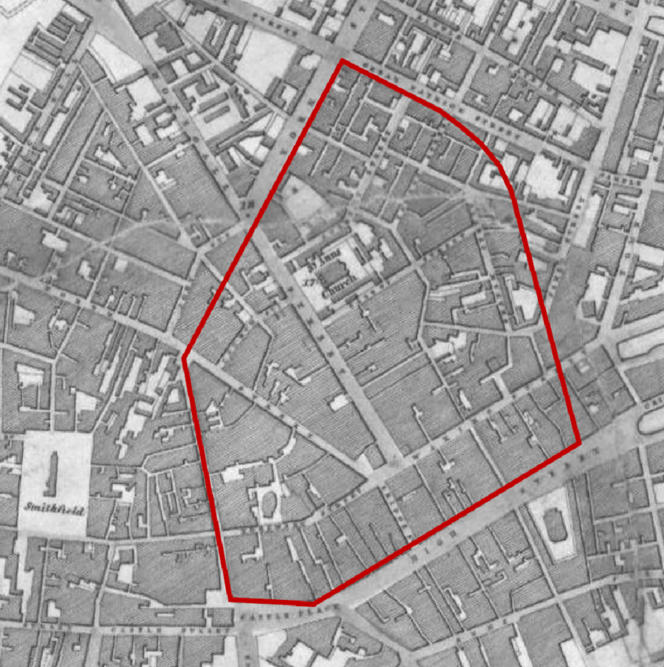6. DOA_07 Cathedral and North East Quarter
Background
DOA_07 Cathedral Quarter covers an area of approximately 17.7 hectares bounded to the north and east by the Dunbar Link, to the south by High Street and to the west by Royal Avenue and York Street. In terms of topography, there is a fall of around 1.9m in a south east direction across the DOA from the highest point at York Street and Royal Avenue to the lowest point along High Street.
This DOA is located within the historic core of Belfast, an area which has been part of the evolution of the city that dates to the seventeenth century with a multitude of recorded archaeological and historic features. The area boasts a rich literacy heritage, with publications such as ‘The Northern Whig’ a popular newspaper circulated from 1824 to 1963. Standing at the junction of Waring Street and Bridge Street, The Northern Whig now houses a popular pub and restaurant. Nearby the listed neo-Romanesque St Anne’s Cathedral built in 1899, forms a key focal point and popular tourist destination.
Traditionally the centre of Belfast’s trade and warehousing district, the Cathedral Quarter soon emerged as a direct response to the prosperous linen and shipbuilding industries synonymous with the city. The decline of these industries saw an incremental degradation of buildings, culminating in the area falling into a state of disrepair in the twentieth century. Following a more recent growth in arts and culture-based organisations, the area is now home to some of the city’s most loved arts and cultural spaces and hosts an extensive calendar of festivals and events. A fast-growing hospitality sector has also seen significant investment in the form of hotels, bars, restaurants and venues within its close knit streets.
In more recent years this DOA has witnessed significant change, notably the relocation of Ulster University’s Jordanstown campus and the construction of several new student accommodation buildings along York Street. Cathedral Gardens Park, which opened in August 2020, saw the transformation of a poorly designed and underused space into a fun gathering space.
Photograph of new Ulster University campus on York Street

Historic plan illustrating narrow streets, dense blocks and tight urban grain across the DOA

Placemaking principles
Development proposals should accord with these placemaking principles which seek to underpin the positive attributes of the DOA and align with policies contained within the Local Development Plan.
- A heritage-led approach that seeks to restore and revitalise historic building stock, including listed buildings and key unlisted historic assets, to secure their viable and sustainable future.
- Integrate high quality architecture within a backdrop of revitalised historic building stock.
- Strengthen physical and visual connections with surrounding neighbourhoods.
- Increase city centre living opportunities through appropriate medium to high densities.
- Accommodate commercially viable uses while respecting the character and historic grain.
- Incorporate plot sizes that reflect and respect the historic grain across the area.
- Enhance the public realm and pedestrian experience through the realisation of a network of new streets, laneways and arcades
- Seek to resolve the practical issues of movement, legibility and traffic
- Enhance the evening and night-time economy
Development requirements
Development requirements are bespoke to this area and could be considered or inked to major planning permissions impacting the DOA by way of legally binding contracts such as Section 76 planning agreements.
Improved infrastructure
- Contribute to boulevard treatment along Royal Avenue, North Street, Donegall Street, Victoria Street and Great Patrick Street.
- Open space and public realm
- Contribute to an exemplar city park or urban forest adjacent to St Anne’s Cathedral
- Contribute to a series of civic spaces across the area including a reconfigured Writers’ Square
Improved connections and permeability
- Contribute to a series of laneways and entries including a re-imagined North Street arcade, new laneway next to Braddells and a series of laneways connecting Hill Street, Talbot Street and Gordon Street.
- Contribute to new streets linking North Street to Writers’ Square, Donegall Street and Rosemary Street to Upper Lombard Street
Historic plan illustrating the many narrow streets, dense blocks and tight urban grain across the DOA

